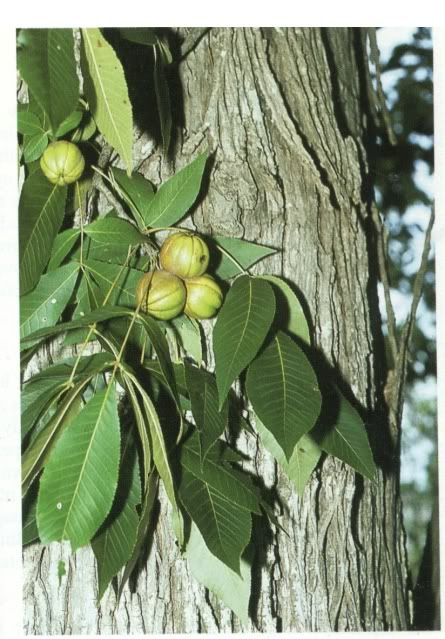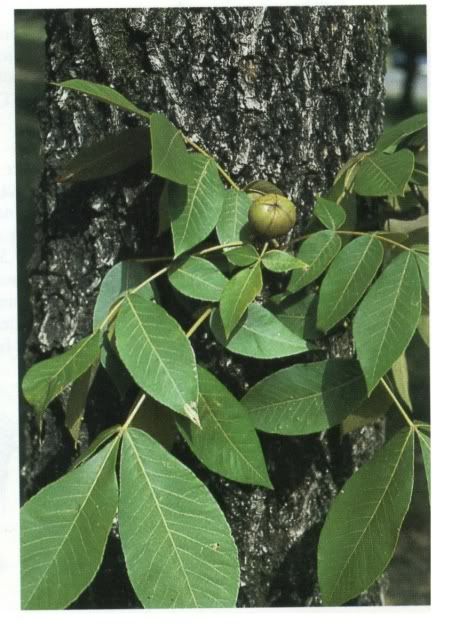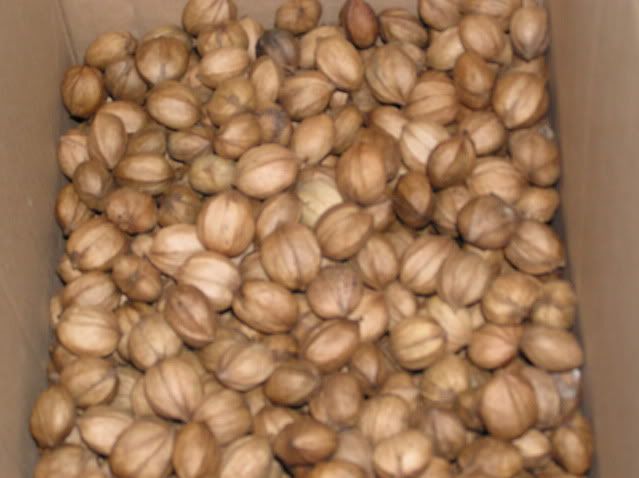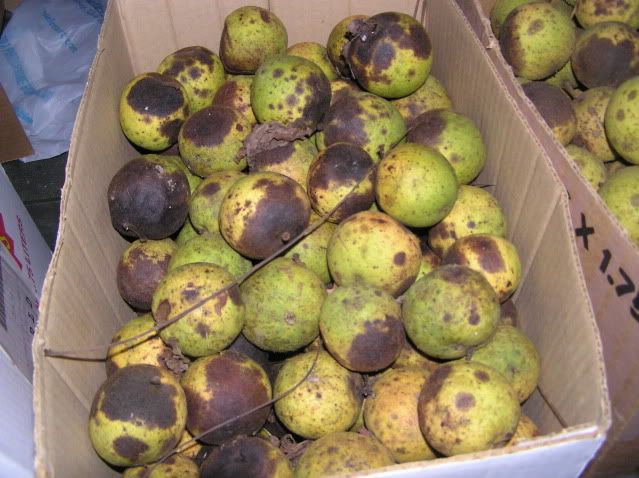Today was a splendid day in the Bluegrass. The temperature was in the low 70s, only a very light breeze, and not a cloud in the sky. The Woman had gone to birthday party for a relative, but when she got home I took over the pumpkin pie that we had baked together last night and we each had a piece. The crust, described here, was perfect.
I left a generous portion of the pie, and she gave me a big hunk of the pumpkin roll that we also made last night. I knew that she was going to be busy later in the day, so I went nutting. My target today was hickory nuts, getting ready for holiday baking. There is a tree that is a reliable cropper just about half a mile from my house, in the yard of some very nice people who always tell me to get as many nuts as I care to pick up, and so I did. Within an hour I had enough clean nuts for all of the holiday cooking, and then some.
The genus Carya is predominately a North American one, but there are Asian species as well. There are at least 14 North American species, and, depending on the authority, perhaps more. They sometimes hybridize with each other, so there are lots of varieties in the wild. Even within a given species, there is a lot of tree to tree variation, so when you find a tree that you like you tend to stay with it.
The particular tree from which I picked up nuts today was of the species C. ovata, the Shagbark Hickory. The nuts are small, the largest being about three cm long. They are flattened, being about 2.5 cm wide and 1.2 cm thick. Even though they are small, the shells are quite thin, leaving a lot of room for meat. They can easily be cracked with a fair sized pair of Channelok pliers, so hammering is not necessary. I am pretty sure that this tree is a Southern Shagbark, C. ovata australis because of the leaf and nut size.
Few people eat hickory nuts these days, mostly because it is more difficult to extract the meat than for most nuts. The native Americans ate lots of hickory nuts, either with the meats extracted or the entire nut pounded to a powder and the woody part partially removed with hot water.
We shall get back to the esculatory properties of the hickories later. The hickories are some of the most important timber woods in North America, but for quite specialized uses. In addition, only a relatively few species are good for these uses. Hickory is unexcelled amongst North American wood for having a combination of properties that make it ideal for use where strength, stiffness, hardness, and resiliency are required. Hickory is still the wood of choice for all kinds of tool handles, because even though it is stiff, it has just enough flexibility not to break under extreme conditions of impact and torsion.
It was formerly used for baseball bats, and by most accounts is superior to ash, but for some reason ash gained favor over it. It is the best wood for drumsticks, and Keith Moon was able to find a way to break lots of them! Before the advent of steel and alloys for vehicle wheels, hickory was almost always used. In the old covered wagons, the wheels and other mechanical parts were made of hickory, and the wooden parts that were not subjected to high levels of stress from less expensive woods. Because hickory can be bent by using steam, boiling water, and pressure and will keep its shape, it was also used as the supports for the cloth covering of the wagons.
Hickory is rarely used for static structural purposes because it is too expensive and too heavy for modern techniques, but was used in the past a lot. It is straight grained, but tends to split when nailed. However, when doweled or used in mortise and tenon or dovetail joints, it is wonderful, and was much used for furniture in the old days.
Hickory is very much in demand for home heating for those who use wood for heat because it has a high thermal content. Like oak, it also forms good beds of coals and burns with a relatively smokeless flame. Along with oak, it is the raw ingredient for most of the charcoal used in the United States. Both oak and hickory are too valuable to burn except when locally harvested where it is abundant, but for charcoal pieces of hickory that are unsuitable for other uses, like slabs from the edges of the trunk and the smaller branches, are well suited for charcoal.
I had a friend when I was a lad whose father had a deal with a tool handle company in Greenland, Arkansas to buy the crooked, knotty, or otherwise unusable handle blanks on the cheap. He would take his two ton pickup truck to Greenland several times during the winter and load it down with reject tool handles and burn them in his fireplace. They were the perfect size, and Al kept his house toasty warm with these handles.
Most people have experience with hickory as a flavoring agent for smoked meats, like bacon or ham. I really like the flavor that hickory imparts to smoked meat, although I do not eat a lot of it. The only wood that I think is as good as or, perhaps, better than hickory for flavoring meat is fruit wood like apple. I detest mesquite, with its tarry and resinous taste. Lots of hickory is used for smoking meat, making it one of the chief uses for hickory.
I once had the opportunity to cut down a hickory of moderate size, maybe with an eight inch trunk diameter. I hate to cut a hickory, but our yard at the time had way too many trees in it and I strategically removed ones that were in bad places. Besides, a hickory is not the best of yard trees because the nuts and husks have to be raked and disposed. Anyway, I cut some of the straight grain trunk to six inch lengths and then split them into pieces about as thick as my thumb. Those sure were nice to use when I smoked chickens or turkeys in the smoker! The fragrance coming from the smoker was superb.
You can buy hickory chips or chunks at most big box stores for use in your smoker or grill, and they work well if you soak them in water so they do not just burn away all at once. You can also buy “liquid smoke”, and extract of hickory smoke and use it in the kitchen. It is made by passing hickory smoke through water and then bottling the water. I keep some around for cooking inside when the weather is too poor to use my grill or smoker. Those are rare occasions, as I like to cook outside.
Smoke was not originally used to give meat a nice flavor, but rather to help preserve it. Smoke contains a number of antioxidant agents, such as polyphenols, that help keep the fat in the meat from going rancid, and it also has a mild antiseptic effect. However, it also contains polycyclic aromatic hydrocarbons, many of which are carcinogenic. At the levels that commercial smoked meat contains, that is probably not too much of a concern, but it is best to avoid a diet really high in food that has been heavily smoked. The liquid extract also contains these materials, but because they are not soluble in water they tend to separate from the flavorful water soluble compounds. Thus, do not shake your liquid smoke and avoid using the dark brown, oily drops.
Back in the days of allowing livestock, in particular hogs, to run wild in the woods, hickory nuts provided a significant source of food for them in the fall, fattening time. This was called mast, and the thin shelled hickories were important. Even more important was the American chestnut, almost extinct in the wild now due to a fungal infection that came here from Europe. Mast is no longer important for raising livestock in the US, but still provides a huge food source for wild animals.
One usually thinks of squirrels with acorns, but given a choice they will always take hickory nuts. Acorns have little fat in them, but hickory nuts are full of a very nutritious oil. Squirrels can gnaw through even the thickest hickory shells and eat them with gusto. Many hickory trees are seedlings that result from nuts hidden by squirrels during the fall and forgotten, only to germinate the next spring. Hickory nuts require a freeze to become able to germinate, so do not think that you can just pick up a bunch of them, keep them inside, and have them come up next year. It is better to allow them to dry out (cure) in the open air, then put them in some kind of a can with some holes in it outside in a dry place for the winter. This is called stratification. You can plant them next spring and most of them will germinate.
Most people have eaten one kind of hickory nut, but it is quite unlike most of the other species. This one, C. illinoinensis, is one of the favorite nuts in the US and tremendous quantities of them are grown commercially. The shell is thinner than in other hickories, and it is a very dependable cropper. We call it the pecan. Many commercial varieties are grown, mostly developed to produce heavy crops of uniform, thin shelled nuts. My father planted a papershell pecan in the front yard at Hackett and we had all the pecans that we needed for all of our cooking every year. You can find pecans at almost any store that sells groceries. They are not cheap, but they are awfully good. I prefer to get them in the shell, because the intact nut keeps better than the extracted nutmeats. Oxygen is your enemy with almost all nuts (chestnuts, being low in fat, are an exception) because most of the fat in nuts is unsaturated. The intact nut has a natural oxygen barrier, and the nutmeat is also not disturbed. You can preserve shelled nuts in glass in the freezer, but you need to get as much oxygen out of the jar as possible before freezing them, and that is not all that easy at home. The simplest method is to put the open jars in a low oven until the nutmeats get good and warm, then putting on the lid before they cool. The partial vacuum has less oxygen than the atmosphere.
Next to the pecan tree in my front yard whilst I was growing up was a hickory, most likely a mockernut, C. tomentosa. This particular tree was a heavy cropper, with fairly large nuts with rather thin shells (for a mockernut). The flavor was wonderful, and we used them every year for cooking. Even after the former Mrs. Translator and I married, we would always get a bucket of them to take home. When I traveled a lot I would take quart plastic bags of cracked nuts with me and pick them out whilst I watched TeeVee at the motel.
Picking up hickory nuts, like I did today, is not tedious. I had a cardboard box and found a piece of concrete block on which to sit. I would place the box and block in one place and pick up all of the nuts that I could reach, then move to the next spot. Often I could get a couple of dozen of the nuts from each place. Unlike black walnuts, the husk from hickory nuts separates into four hard, dry segments. It is possible to collect only husked nuts, with the only processing before cracking and picking out the nutmeats being curing in a dry place for a couple of weeks. I got all that I needed in an hour and they are clean.
The walnuts that I picked up Thursday are another story. I have to husk them (wearing rubber gloves to avoid staining my hands) by driving them through a hole in a board to remove the husk, then pressure washing them to remove the rest of the staining husk and its juice, then put them in a single layer in wire baskets, then use a fan to cure them for about a month before cracking and picking out the nutmeats.
As I said previously, there are many other Carya species in North America. All of them produce nuts, some better than others. Notable for large, thin shelled, and very good nuts is the Shellbark Hickory, C. laciniosa. Other than the pecan, it is the only hickory grown commercially for nuts.
If you are out and about and see a hickory with nuts on the ground, pick up a few and crack them and give them a taste. No hickory produces toxic nuts, and they are easy to identify because of the four lobed, hard husk. You must realize that the flavor is not at peak as soon as they fall off of the tree, because they have to cure for a while to develop it, but since they usually come out of the husk on impact, you may find some already close to cured. Even within a given species (for the most part) the quality of nut can range from too bitter to eat to wonderful or from too much shell for the meat to be worth it to very thin shells with lots of meat.
There is a notable exception with which I have personal experience. C. aquatica, the Bitter Pecan, is just awful. I have never tasted such an astringent and horrible nut in my life. My father was sort of a prankster and once brought a bag of them on a visit to the former Mrs. Translator, the boys, and me. They looked delicious, almost like a regular wild pecan. He offered one to me, and I gladly ate it. After I was done with the cursing, I thought that the former Mrs. Translator should try one, too, since she was out of the room at the time that I tried one. Sure enough, she thought that they looked great. Her demeanor changed dramatically as she chewed on a kernel and the only similar face of disgust that I can remember was when my grandmum tried to drink milk of Magnesia straight from the bottle that had been in a hot car. She did not hold a grudge, though, and was delighted to see similar reactions in the boys as they tried theirs!
All in all, the genus Carya is an interesting and important one. Here are a couple of pictures to help you to identify hickories. As I said, none of them are toxic and all look very much the same. As a matter of fact, even botanists disagree sometimes which species is which.
Here is a picture of a Shagbark. Note the grey, shaggy bark. The leaves and nuts are pretty typical of all hickories:

This one is a picture of a Mockernut. Note the very dark, furrowed bark.

Here is my haul of Shagbark nuts from today. It might not look like a lot, but that will be plenty for the season. Note how clean the nuts are.

And, finally, here are the black walnuts from Thursday:

I have three full boxes of walnuts, but after removing the husks and pressure washing them, I expect to have less than one box left. I hope that they are better than the ones last year, because only one in eight or nine were good. Usually, eight or so out of ten are good. Hickory nuts usually are almost all good. If most of the walnuts are good, then I should have not only enough for holiday goodies, but when it gets warm next year I can use some to make one of the truly great confections that exists, black walnut homemade ice cream!
That about does it for this evening. I should be available for most of the evening for Comment Time since The Woman is not available this evening, but my fortune could change for the better. I shall return for Review Time around 9:00 tomorrow evening to answer late comments.
Warmest regards,
Doc
Crossposted, with minor modification, at
Docudharma, and

1 comments
Author
good, wild food?
Warmest regards,
Doc